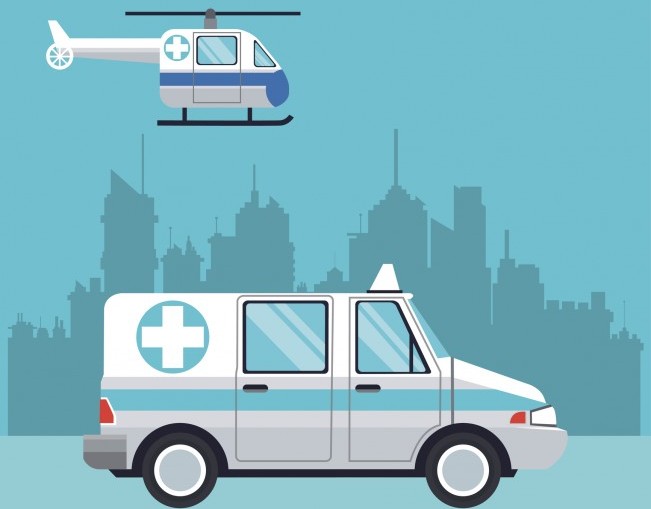Emergency Air Ambulances Put Patients at Risk for Balance Billing
Patients who use out-of-network emergency air ambulances are at financial risk for balance billing.

Source: Thinkstock
- Privately insured patients transported by emergency air ambulances outside their coverage networks are at high risk of balance billing, also known as surprise billing, according to a GAO report.
Just under 70 percent of air ambulance transports conducted in 2017 were out-of-network, a significantly higher rate than other emergency services, the report found.
Air ambulances provide emergency transport for critically ill patients, primarily in life-threatening situations, GAO noted. Providers also call for air ambulances to transport individuals between hospitals when patients need higher levels of care, such as specialized trauma or stroke care.
In the last few years, the price and prevalence of air ambulance use have increased, the agency said.
“The air ambulance industry, particularly as it relates to air ambulance helicopters, has seen numerous changes in recent years,” GAO wrote.
READ MORE: Health Plans Ask Congress for Unified Action on Surprise Billing
“In 2017, we reported that between 2010 and 2014 the median prices charged by air ambulance providers for helicopter transports approximately doubled, and the number of air ambulance helicopters grew by more than 10 percent.”
GAO also found that between 2012 and 2017, air ambulance providers opened new helicopter bases in rural areas, as well as in areas where there is existing air ambulance coverage. These new bases can enhance patient access to available services and improve outcomes.
However, for some, this method of transport can also result in increased costs. Patients generally have no control over the decision to be transported by air ambulance or the selection of the air ambulance provider, the report stated. For patients with private insurance, air ambulances can lead to sky-high balance bills.
“For privately-insured patients who receive air ambulance services, balance billing can occur when they are transported by air ambulance providers outside of their insurers’ provider networks, which means the providers and insurers do not have an agreed-upon payment rate,” GAO said.
To understand the extent of balance billing for air ambulance transports, and to discover what policymakers are doing to limit balance billing, GAO interviewed officials in six states, including Florida, Maryland, Montana, North Dakota, Texas, and New Mexico. The agency also analyzed health insurance claims from FAIR Health for 2012 and 2017.
READ MORE: Payers, Providers, Lawmakers Debate Surprise Billing Guidelines
“The proportion of out-of-network air ambulance transports in the FAIR Health data set is higher than what research shows for ground ambulance transports and other types of emergency services,” GAO said.
“One study found that 51 percent of ground ambulance transports in 2014 were out-of-network, and the same study and another one found that 14 and 22 percent of emergency department visits in 2014 and 2015 involved out-of-network physicians, even at in-network hospitals.”
When interviewed by GAO, air ambulance providers and insurers acknowledged that their out-of-network transports increased significantly in 2017, and some said they have recently been entering into more network contracts.
“For example, one of the large independent air ambulance providers and a national insurer entered into a contract that covered patients in five states as of August 2018,” the report said.
“These contracts could decrease the extent of out-of-network transports and balance billing in the future for these states.”
READ MORE: AHIP, Payer Groups Agree to Focus on Nixing Surprise Billing
Although out-of-network transports could result in balance billing, the FAIR Health data does not offer information on the extent to which patients received balance bills, or on the size of the bills, GAO stated.
However, some states have attempted to collect this data. Maryland found about two dozen complaints from patients containing information on the cost of balance bills, which ranged from $12,300 to $52,000. North Dakota data showed three dozen complaints from patients about balance bills ranging from $600 to $66,600.
While air ambulance providers offer various payment options, discounts, and payment plans for patients, balance bills remain costly.
“Even with discounts, according to data from some air ambulance providers we spoke with, the amount patients pay can still be in the thousands of dollars,” the report said.
To limit balance bills, four of the six states GAO selected are attempting to regulate insurers. Montana, New Mexico, North Dakota, and Texas have leveraged insurance laws and regulations that aim to curb balance billing, with officials in Montana and North Dakota reporting that they have received fewer consumer complaints after implementing regulations.
In Florida, New Mexico, and North Dakota, officials have provided information to educate patients and other stakeholders about balance billing for air ambulance transports.
Florida issued a report in June 2018 recommending that insurers and air ambulance providers improve transparency about the availability of in-network air ambulance providers in a given area.
New Mexico also issued a report advising that healthcare providers learn about the impact of air ambulance balance bills on patients, and North Dakota has created a public guide that shows which air ambulances are in-network.
GAO has also taken steps to reduce air ambulance balance billing. The agency proposed four recommendations to the Department of Transportation (DOT) in 2017 to increase transparency. GAO advised that DOT communicate a method for receiving air ambulance complaints and taking steps to make complaint information publicly available.
Additionally, GAO suggested that DOT assess available data to determine what information could assist with future complaints, and consider consumer disclosure requirements for air ambulance providers.
“DOT has taken steps to respond to the first two recommendations, including adding information to its website describing how air ambulance complaints can be registered and used by DOT,” GAO concluded.
“It has also listed the number of air ambulance complaints filed with DOT each month starting in January 2018 – 23 air ambulance complaints have been filed with DOT through November 2018. DOT has not yet acted on the remaining two recommendations.”
